If your Firefox browser keeps redirecting you to unwanted websites or pops up with advertisements while you surf the Internet, you may have malware installed on your computer.
Table of Contents
- Firefox browser is infected with Malware
- Seeing pop-up ads and redirects in Firefox
- Remove malware from Firefox
Firefox browser is infected with Malware
When the Firefox browser is infected with malware, your home page or search engine may change against your will, or you may see pop-ups & unwanted advertisements from the sites you browse. Adware, browser hijackers, malicious and extensions are the most common types of browser infections. Let’s look at each of these threats.
- Browser hijackers are nothing new and malware developers have used this technique for years to generate traffic to their websites, collect search terms, & redirect users to websites where they receive a commission or some form of revenue. The browser hijacker changes your browser’s search provider to generate advertising revenue by using Google Search, Yahoo Search, or Bing Search for its search results.
- Adware is usually unwanted software designed to throw advertisements on your screen in a web browser. These advertisements cover the content of the page & when you click on a link, it opens a popup to another advertisement. When a malicious program displays advertisements, it may appear in pop-up windows, directly on a web page you visit, or as videos, banners, moving ads, or as page folds in the upper right corner of the page. website. Also, you may experience new tabs opening, a change to your home page, discoveries from a search engine you’ve never heard of, or a redirect to an NSFW website.
- Malicious browser extensions are offered through advertisements & once installed can collect personal data about your browsing habits or change browser settings. If you see a new browser extension that you don’t remember installing, there’s a good chance you have malware on your system.
Common signs that your Firefox browser is infected with malware
- Advertisements appear where they shouldn’t be.
- Your browser’s search engine has been changed without your permission
Your web browser’s homepage has been mysteriously changed without your permission. - Web pages you normally visit may not display properly.
- Website links redirect to different sites than you expect.
- Browser pop-ups appear that recommend fake updates or other software.
- Other unwanted programs may be installed without your knowledge.
Seeing pop-up ads & redirects in Firefox
You are seeing pop-up ads & redirects in your Firefox browser because your computer is infected with malware or another website is redirecting you to these pages.
In many cases, malicious Firefox browser extensions or programs are distributed using malicious advertisements or bundled with other free software you download from the Internet, leaving the user puzzled as to where it came from.
If you’re not sure how a Firefox extension was installed or suspect that unwanted programs have been installed on your computer or phone. Remove it using the instructions below.
We hope to help people remove malware from their Firefox browser, so if you’re looking for a way to block redirects or pop-up ads on a specific website, you can install an adblocker like AdGuard.
Remove malware from Firefox
This article may seem long because we provide clear, detailed & easy-to-understand instructions that anyone can use to remove malware for free. Please do all the steps in the correct order. If you have any doubts at any point, stop by and ask for our assistance.
Firefox can be infected with malicious extensions, adware, browser hijackers, or other malware while using Windows, Mac, or Android.
Remove Malware from Firefox – Windows
STEP 1: Uninstall MALICIOUS Programs in Windows
In our first step, we will manually check if any unknown or malicious programs are installed on the computer. Sometimes adware & browser hijackers have an uninstaller that can be used to remove them.
WINDOWS 11
1. Open Windows Settings.
First, press “WINDOWS+I” on your keyboard to open Windows Settings. You can right-click your Start button and select “Settings” from the list.
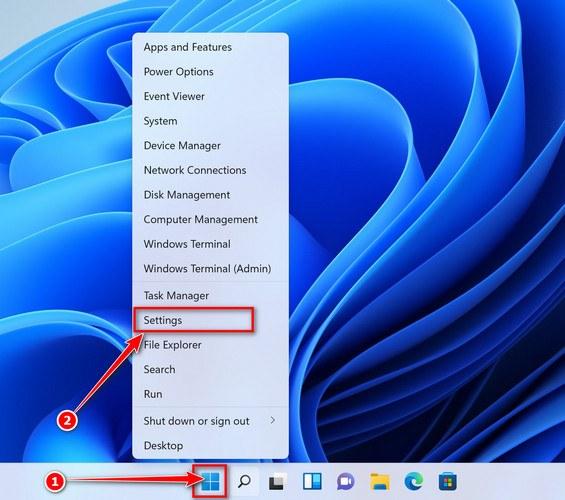
2. Click on “Applications”, then select “Applications & Features”.
When Settings opens, click “Apps” in the sidebar, then select “Apps & Features.“.

3. Find & uninstall all malicious programs
In Apps & features settings, scroll down to the apps list and look for unknown or suspicious programs. When you find a malicious program, click the three-dot button next to it and select “Uninstall” from the menu that appears.
NOTE
Look for any suspicious programs that might be behind all the drama – anything you don’t remember downloading or that doesn’t look like a genuine program. If you can’t find any malicious programs on your computer, you can continue with the second step of this guide.

4. Use the on-screen prompts to uninstall the program.
In the next message box, confirm the uninstall process by clicking “Uninstall“. Then follow the prompts to uninstall the malicious program
Be sure to read all prompts carefully. Some malicious programs try to sneak things in hoping you won’t read them closely.

WINDOWS 10
1. Open the “Settings” menu.
Click the Start button on the taskbar, then select “Settings.”

2. Click on “Applications”, then click on “Applications & Features”.
When the “Windows Settings” window opens, click on “Applications”. By default, it should open “Apps & Features,” but if it doesn’t, select it from the list on the left.

3. Search for malicious programs and uninstall them.
The “Applications and Features” screen will be displayed with a list of all the programs installed on your computer. Scroll through the list until you find an unknown or suspicious program, then click to highlight it, then click the “Uninstall” button.

4. Use the on-screen prompts to uninstall the malicious program.
In the next message box, confirm the uninstall process by clicking on Uninstall, then follow the prompts to uninstall the malicious program.
Be sure to read all prompts carefully. Some malicious programs try to sneak things in hoping you won’t read closely.

WINDOWS 8
1. Go to “Programs & Features”.
Right-click the Start button on the taskbar, then select “Programs & Features.” This will take you directly to your list of installed programs.

2. Look for malware and uninstall it
The “Programs & Features” screen will display a list of all the programs installed on your computer. Scroll through the list until you find an unknown or suspicious program, then click to highlight it, then click the “Uninstall” button.

3. Follow the on-screen prompts to uninstall the malicious program.
In the next message box, confirm the uninstall process by clicking on Yes, & then follow the prompts to uninstall the malicious program. Be sure to read all prompts carefully. Some malicious programs will try to sneak things that you hope you won’t read closely.
WINDOWS 7
1. Open “Control Panel”.
Click on the “Start” button, then click on “Control Panel“.

2. Click –> “Uninstall a program”.
When “Control Panel” appears, click on “Uninstall a program” from the Programs category.

3. Search for malicious programs and uninstall them.
The “Programs and Features” screen will display a list of all the programs installed on your computer. Scroll through the list until you find any suspicious or unknown program, then click to highlight it, then click the “Uninstall” button.

4. Follow the on-screen prompts to uninstall the malicious program.
In the next message box, confirm the uninstall process by clicking on Yes, & then follow the prompts to uninstall the malicious program. Be sure to read all prompts carefully. Some malicious programs will try to sneak things that you hope you won’t read closely.
STEP 2: Use Malwarebytes to remove Firefox browser hijackers & adware
In this second step, we’ll download, install, and run a scan with Malwarebytes to remove browser hijackers, malicious extensions, adware, & other malware from Firefox.
Malwarebytes is the most popular & most used anti-malware software for Windows, & for good reason. It is capable of killing most of the malware that other software can avoid, without costing you any money. When it comes to cleaning an infected device, Malwarebytes is always free and we recommend it as an essential tool in the fight against malware.
1. Download “Malwarebytes” Software for Windows.
Download Malwarebytes by using the link given below.
https://malwaretips.com/blogs/downloads-malwarebytes-for-windows/
2. Double-click the Malwarebytes setup file.
When Malwarebytes is finished downloading, install Malwarebytes on your computer by double-clicking the MB setup file. Downloaded files are usually saved to the Downloads folder.

You will be presented with a User Account Control popup asking if you want to allow Malwarebytes to make changes to your device. If this happens, you must click “Yes” to continue installing Malwarebytes.

3. Use the on-screen prompts to install Malwarebytes.
When the Malwarebytes installation begins, you will see the Malwarebytes setup wizard that guides you through the installation process. The Malwarebytes installer will first ask you what type of computer you are installing the program on, click Personal computer or Work computer.

On the next screen, click “Install” to install Malwarebytes on your computer.

When your Malwarebytes installation is complete, the program will open to the Welcome to Malwarebytes screen. Click the “Start” button.
4. Click on “Scan”
To scan your computer with Malwarebytes, click the “Scan” button. Malwarebytes automatically updates the antivirus database & starts scanning your computer &Firefox browser for malware.

5. Stay for the Malwarebytes scan to complete.
Malwarebytes scans your computer for browser hijackers, malicious extensions, adware, & other malware. This process may take a few minutes, so we suggest you do something else & check the scan status periodically to see when it’s finished.

6. Click on “Quarantine”
When the scan is complete, Malwarebytes will present you with a screen showing the detected malware infections. To remove malware detected by Malwarebytes, click the “Quarantine” button.
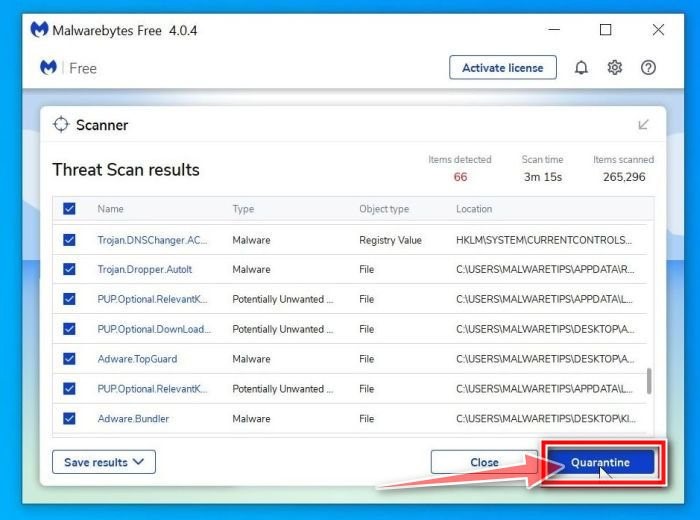
7. Restart the computer
Malwarebytes will now remove all malware it finds. Malwarebytes may ask you to restart your computer to complete the malware removal process.

When the malware removal process is complete, you can close Malwarebytes & continue with the rest of the instructions.
STEP 3: Use HitmanPro to scan your computer for Trojans and other malware
In this next step, we will scan your computer with HitmanPro to ensure that no other malicious programs are installed on your computer or browser.
HitmanPro is a second opinion scanner. It takes a unique cloud-based approach to malware scanning. HitmanPro scans active files for behavior and suspicious activity in locations where malware is commonly found. If it finds an already unknown suspicious file, HitmanPro sends it to its cloud to be scanned by two of the best antivirus engines, Bitdefender and Kaspersky.
Although HitmanPro is stock software & costs $24.95 for a year on 1 computer, there is actually no limit on scanning. The limit starts only when you need to remove or quarantine malware detected by HitmanPro on your system, at which point, you can activate the 30-day trial to enable cleaning.
1. Download HitmanPro
Download HitmanPro by using the link given below.
https://malwaretips.com/blogs/downloads-hitmanpro/
2. Install HitmanPro
When HitmanPro is finished downloading, double-click
32-bit versions of Windows-“hitmanpro.exe”
64-bit versions of Windows-“hitmanpro_x64.exe” to install the program on your computer.

You will be presented with a User Account Control popup asking if you want to allow HitmanPro to make changes to your device. If this happens, you must click “Yes” to continue the installation.

3. Use the on-screen prompts
Click the “Next” button to scan the system. When HitmanPro starts you will get a splash screen as shown below.
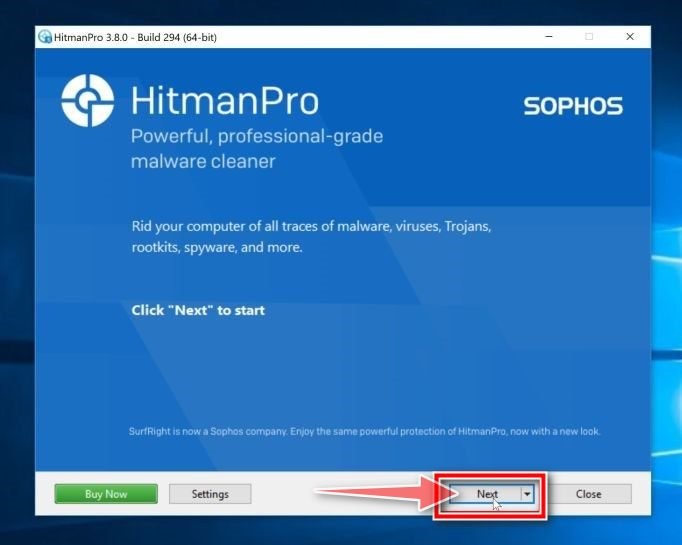
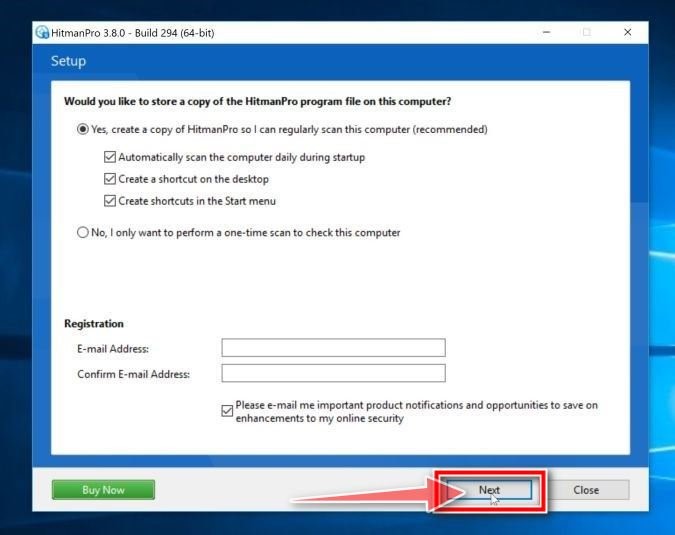
4. Stay for the HitmanPro scan to complete.
In this step, HitmanPro starts scanning your computer for Trojans, unwanted programs, & other malware.

5. Click on “Next”
After HitmanPro has finished scanning, it will display a list of all the malware the program found.
Then click on the “Next” button to remove the malware.

6. Click –>”Activate Free License”
Click the “Activate Free License” button to start the free 30-day trial & remove all malicious files from your computer.
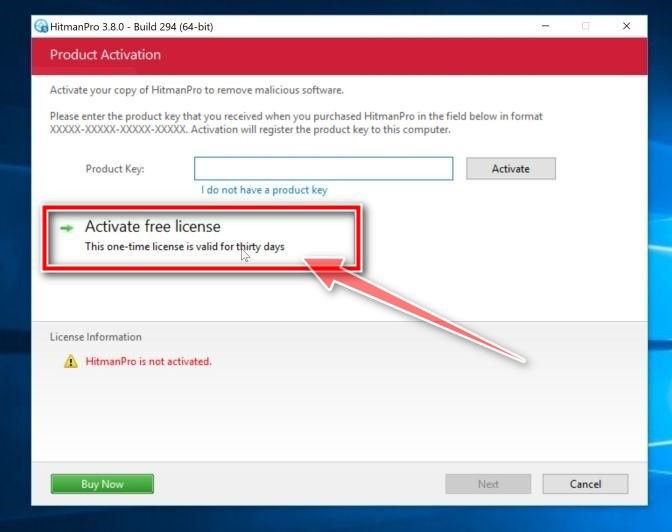
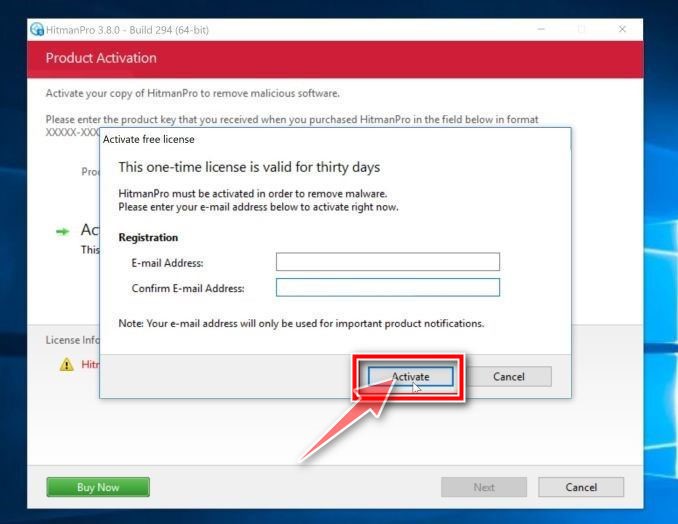
STEP 4: Use AdwCleaner to remove malicious browser policies
In this fourth step, we will use AdwCleaner to remove malicious browser policies set by browser hijackers & remove malicious browser extensions from your computer.
AdwCleaner is a popular free on-demand scanner that can detect and remove malware that even the most popular antivirus & anti-malware applications fail to detect. This on-demand scanner includes many tools that can be used to fix browser hijacker side effects.
1. Download AdwCleaner.
Download AdwCleaner by using the link given below.
https://malwaretips.com/blogs/downloads-adwcleaner/
2. Double-click the setup file
To start AdwCleaner Double click on the file named “adwcleaner_x.x.x.exe”. Usually, the downloaded files are saved to the Downloads folder.

You may be presented with a User Account Control dialog asking if you want to run this file. If this happens, you must click “Yes” to continue the installation process.

3. Remove malicious browser policies by enabling “Chrome Policy Reset”
After AdwCleaner starts, on the left side of the window, click on “Settings“, then enable “Reset Chrome Policies“.

4. Click –> “Scan Now”
On the left side of the window, click on “Toolbar“. Then click “Scan Now” to scan the system.

5. Stay for the AdwCleaner scan to complete
Now AdwCleaner scans your computer for malicious browser extensions, browser hijackers, adware, & other malware. This process may take several minutes.

6. Click –> “Clean & Repair”
After AdwCleaner finishes it will display a list of all the malware that the program found. Then click the “Clean & Repair” button to remove the malware from your computer.

7. Click –>“Clean & Restart Now”
After the malware removal process is complete, AdwCleaner may require you to restart your device. Then click the “Clean & Restart Now” button to finish the removal process.
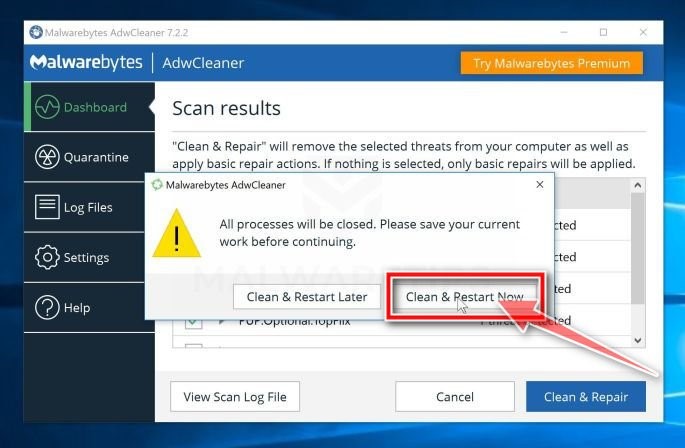
You can close AdwCleaner after the malware removal process is complete. Then continue with the rest of the next steps from this guide.
STEP 5: Remove search engine & malicious browser extensions
In this last step, we will reset the browser to its default settings to remove any malicious browser extension, unwanted search engine, or spam browser notifications.
Firefox
Reset Firefox to default settings to remove malware
We reset browser settings to their defaults to remove malicious browser extensions, unwanted search engines, or spam browser notifications from Firefox. The reset feature solves many problems by restoring Firefox to its factory default state while saving your essential information such as bookmarks, passwords, web form auto-fill information, browsing history, and open tabs.
1. Click the Menu Icon & click on “Help”
Click on Firefox’s main menu button, that represented by three horizontal lines. Once the drop-down menu appears, select the option labeled “Help.”

2. Click–> “More Troubleshooting Information”
On the Help menu, click on “More Troubleshooting Information.”

3. Click –> “Refresh Firefox”
Click the “Refresh Firefox” button that appears in the upper right corner of the “Troubleshooting Information” page.

4. Confirm
To continue, click the “Refresh Firefox” button that appears in the new confirmation window that opens.

5. Click –> “Finish”
Firefox will close itself and return to its default settings. After it is finished, a window will list the imported information. Click on “Finish“.
NOTE
Our old Firefox profiles are placed on your desktop in a folder called “Old Firefox Data”. If the reset didn’t fix your problem, you can recover some of the saved information by copying the files to the new profile you created. If you no longer need this folder, you should delete it as it contains sensitive information.
Chrome
Reset Google Chrome to default settings to remove malware
Quickly reset Chrome You can enter “chrome://settings/resetProfileSettings” into Chrome’s address bar to go directly to the “Reset Settings” dialog box. Then click on “Reset Settings” to restore browser settings
1. Click the Menu Icon & click on “Settings”.
Click on Chrome’s menu button, that represented by three horizontal lines. Once the drop-down menu appears, select the option labeled “Settings”.

2. Click –> “Advanced”
Now Chrome’s “Settings” should show up in a new tab or window depending on your device. Next, scroll to the bottom of the page & click on the “Advanced” link.
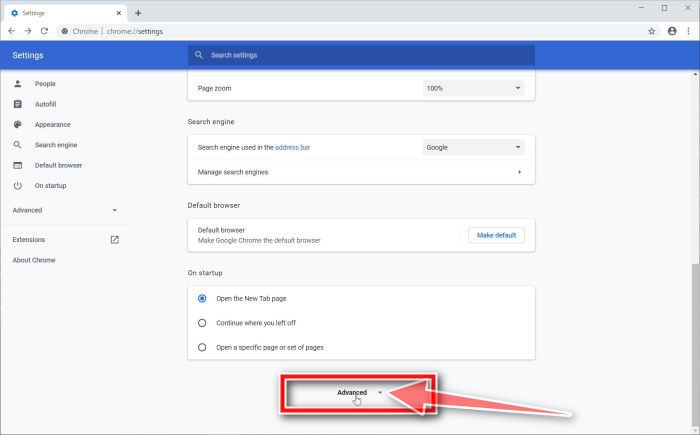
3. Click –> “Reset settings to their original defaults”
Scroll down until you see the “Reset and Cleanup” section. Click on “Reset settings to their original defaults“.
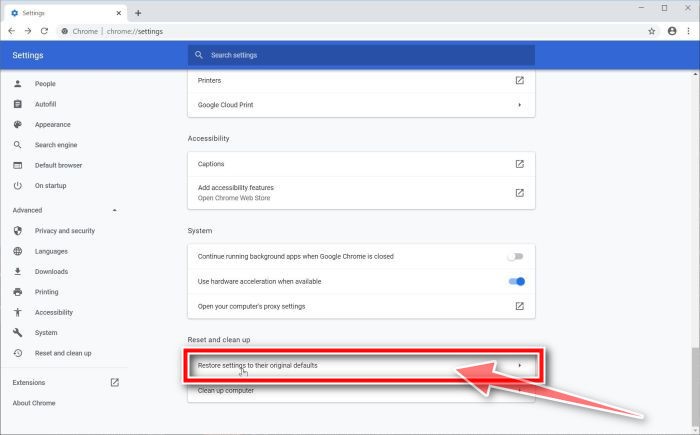
4. Click –> “Reset Settings”
Now it shows a dialog. It includes components that will be restored to their default state if you continue with the reset process. Click the “Restore” button to complete the recovery process.
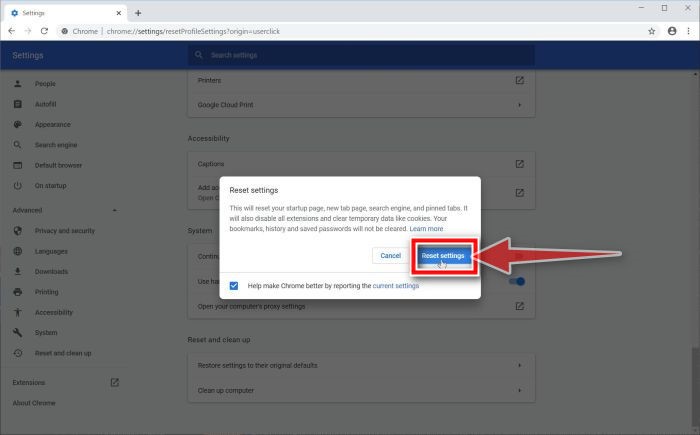
Microsoft Edge
Remove malware from Microsoft Edge
We reset browser settings to their defaults to remove malicious browser extensions, unwanted search engines, or spam browser notifications from Microsoft Edge. This process will reset your start page, new tab page, search engine, and attached tabs. It disables all extensions and removes temporary data. Your favorites, history, and saved passwords will not be cleared.
1. Open “Settings” menu.
Click on Microsoft Edge’s main menu button, that represented by three horizontal dots. After the drop-down menu appears, click on the “Settings“.

2. Click –> “Reset Settings”
Click on “Reset Settings” on the left side of the window.

3. Click –>“Restore settings to their default values”
Click on “Restore settings to their default values” that appears on the left side of the window.

4. Click –> “Reset”
Now it shows a dialog. It includes components that will be restored to their default state if you continue with the reset process. Click the “Reset” button to complete the recovery process.
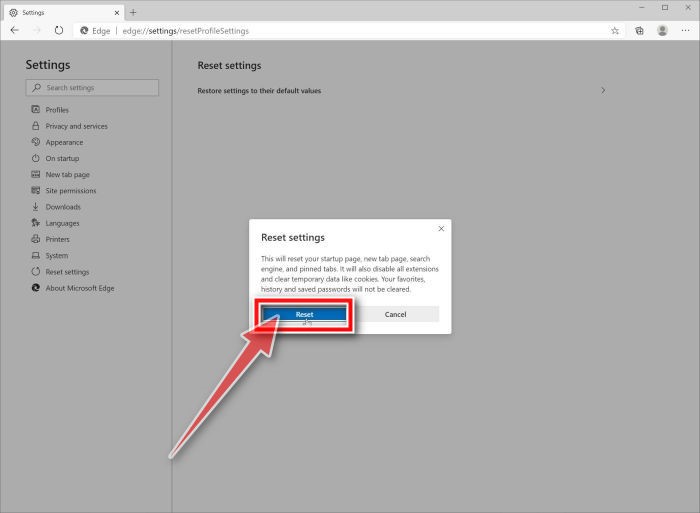
Internet Explorer
Remove malware from Internet Explorer
We reset browser settings to their defaults to remove malicious browser extensions, unwanted search engines, or spam browser notifications from Internet Explorer. You can reset Internet Explorer settings to return them to the state they were in when Internet Explorer was first installed on your computer.
1. Go to–> “Internet Options”
Once you open Internet Explorer, click on the gear icon in the upper right corner of your browser. Select “Internet Options“.
2. Select the “Advanced” tab, & click “Reset”
In the “Internet Options” dialog box, select the “Advanced” tab. After that, click the “Reset” button.
3. Click –> “Reset”
In the “Reset Internet Explorer Settings” section, select “Delete Personal Settings“, then click the “Reset” button.
4. Click –> “Close”
After Internet Explorer completes its work, click the “Close” button.
Close your browser & you can reopen Internet Explorer.
